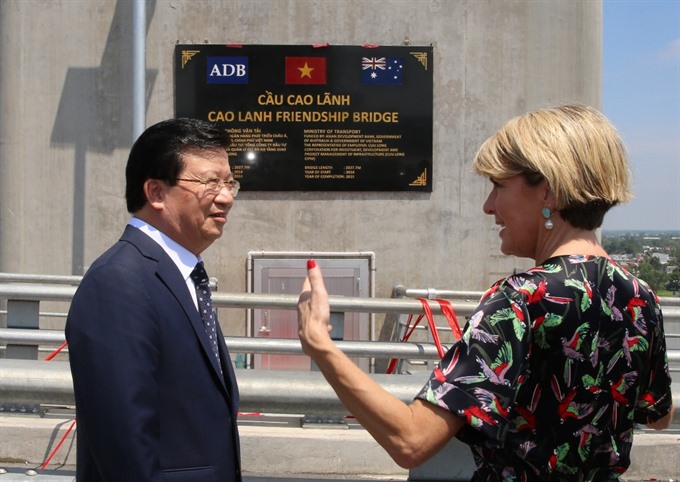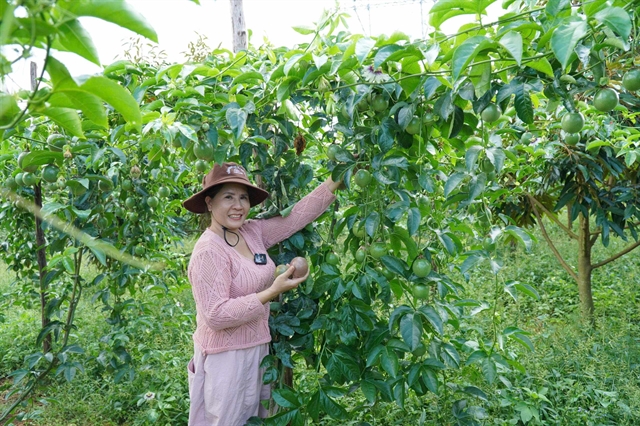 Society
Society

The 2.01km-long cable-stayed Cao Lãnh Bridge linking Cao Lãnh City and Lấp Vò District in the Cửu Long (Mekong) Delta province of Đồng Tháp officially opened to traffic last Sunday (May 27).
 |
| The 2.01km-long cable-stayed Cao Lãnh Bridge linking Cao Lãnh City and Lấp Vò District in the Mekong Delta province of Đồng Tháp opened to traffic on May 27. — VNS Photo Ngọc Diệp |
ĐỒNG THÁP — The 2.01km-long cable-stayed Cao Lãnh Bridge linking Cao Lãnh City and Lấp Vò District in the Cửu Long (Mekong) Delta province of Đồng Tháp officially opened to traffic on May 27.
The bridge spanning Tiền River is located 0.8km from the Cao Lãnh ferry terminal and 35km from the Mỹ Thuận Bridge.
It sits 37.5m above the river and is 24.5m in width. Its 123.4m-high main towers with H-shaped columns are considered an important landmark in the area.
The maximum speed on the bridge will be 80kph. With four lanes for motorised vehicles and two for non-motorised ones, it is equipped with safety monitoring and surveillance camera systems.
Construction of a 21.45km-long interconnecting road linking Cao Lãnh and Vàm Cống bridges through Cao Lãnh City, and Cao Lãnh and Lấp Vò districts in Đồng Tháp Province, has also been completed.
Along with Cần Thơ Bridge, Vàm Cống Bridge, which has not opened yet, is now the second to cross the Hậu River, linking Đồng Tháp Province’s Lấp Vò District and Thốt Nốt District in Cần Thơ City.
The interconnecting road is 20.6m wide, offering four lanes for motorised vehicles and another two for non-motorised ones, with a maximum speed of 80kph.
The opening ceremony was attended by Deputy Prime Minister Trịnh Đình Dũng, Australian Foreign Minister Julie Bishop, Minister of Transport Nguyễn Văn Thể, ADB Country Director Eric Sidgwick, and leaders and officials of the province, relevant agencies, and many local residents.
 |
| Deputy Prime Minister Trịnh Đình Dũng (left) and Australian Foreign Minister Julie Bishop have informal following the official opening of the Cao Lãnh friendship bridge. — Photo baochinhphu.vn |
“This transport project has a great importance to the socio-economic development of Đồng Tháp Province in particular and the Mekong Delta in general,” he said.
Its total cost of about VNĐ7.5 trillion (US$330 million) was sourced from Australian Government’s non-refundable aid, as well as a loan from the Asia Development Bank and the Vietnamese Government’s counterpart capital.
“Cao Lãnh Bridge will stand as an enduring symbol of Australia and Việt Nam’s ties, marking our 45th anniversary of relations and the signing of our new strategic partnership,” said Australian FM Bishop.
She said that, in the years ahead, the bridge would be a crucial driver for development and help better connect the region, as well as support economic growth and food security.
Previously, Australia also offered non-refundable aid to help build the Mỹ Thuận Bridge connecting Tiền Giang and Vĩnh Long provinces, which opened in 2000.
The Cao Lãnh Bridge and interconnecting road project was completed by the investor, Cửu Long Corporation for Investment, Development and Project Management of Infrastructure (Cửu Long CIPM), with design consultancy services and construction supervision from CDM SMITH Inc (US), WSP (Finland), and Yooshin Engineering Cooperation (South Korea).
The project is expected to reduce the travelling time between HCM City and Cần Thơ City, as well as the provinces of An Giang, Đồng Tháp and Kiên Giang.
It will create favourable conditions for trade activities between the delta’s provinces and southern economic hubs whereas local residents will no longer have to catch a ferry to cross the river.
Construction of the Cao Lãnh Bridge began in October 2013 and its final segments were joined last September. Originally scheduled to open to traffic within 43 months, the bridge opening was delayed for a number of unspecified reasons. — VNS




